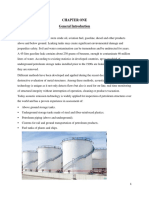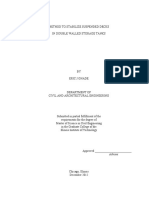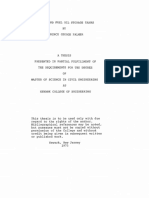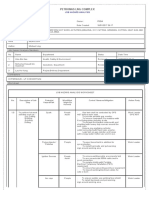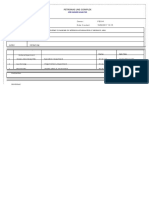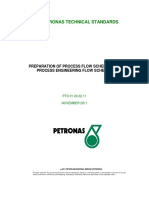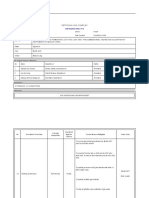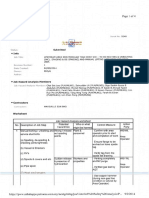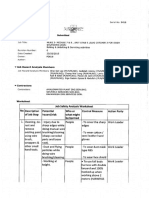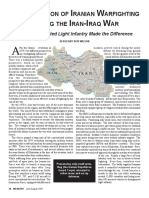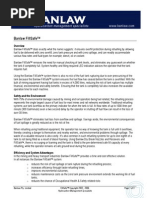Tank Info PDF
Tank Info PDF
Uploaded by
Eric TingCopyright:
Available Formats
Tank Info PDF
Tank Info PDF
Uploaded by
Eric TingOriginal Title
Copyright
Available Formats
Share this document
Did you find this document useful?
Is this content inappropriate?
Copyright:
Available Formats
Tank Info PDF
Tank Info PDF
Uploaded by
Eric TingCopyright:
Available Formats
API 650 EXTERNAL PRESSURE DESIGN APPENDIX
John M. Lieb, P.E.
Tank Industry Consultants
November, 2003
Introduction:
In the near future, API will publish an appendix to API 650 that will prescribe
requirements for the design of tanks that operate at negative pressure (or vacuum).
This paper discusses:
§ The background on the development of the new appendix. Why and how did it
come about?
§ The scope of the document as defined by the Process Industry Practices group.
§ The technical basis of the appendix. Where do the rules come from?
§ The loading conditions and combinations addressed by the appendix. How is
external pressure combined with roof live load and wind load, e.g.?
§ The equations and formulas that are provided for the design of tank components.
What components are included?
§ A design example to illustrate application of the design procedures. What will a
typical tank subject to a significant vacuum design pressure look like?
§ Guidance for cases where tanks are subject to flooding of the dike area
surrounding the tank.
Background:
The request that API 650 include design rules for tanks with external pressure originated
with the Process Industry Practices (PIP) group, a consortium of numerous petroleum
and chemical companies. In response to PIP’s request, API agreed to develop the
requested rules and incorporate them in an appendix to API Standard 650. An API
Special Task Group was formed to develop the appendix. Thus in late 1998, the Task
Group began work on the appendix.
Fortunately, work on external pressure design of tanks that DuPont had already compiled
and implemented in an internal engineering standard was made available to the Task
Group with DuPont’s permission. This document, together with others that are included
in the References section of the appendix, proved to be a great “starting point” in
formulating and presenting the rules for API 650 tanks.
Tank Industry Consultants 1
Since API 650 already states that tanks designed in accordance with the provisions of the
standard can be considered adequate for external pressures up to 1-inch water column,
PIP asked that rules be provided for external pressures greater than this amount.
Process Industry Practices Request:
The PIP request was dated April 15, 1998. The effort has taken about five and on-half
years to this point. The specific Scope of Work defined for the Task Group by PIP was:
“This task group will develop an appendix to the API Standard 650 for external
pressure design. Uniform partial vacuum not to exceed one pound per square inch
gage and partial submergence in near-static liquids shall be considered. Closed
tanks having both supported and self-supporting roofs, anchored and unanchored,
at ambient and elevated temperatures, and of both carbon steel and stainless steel
construction shall be considered. Limitations such as maximum configuration
size and magnitude of external pressure may be imposed for specific geometries,
materials, and loading combinations.”
The Process Industry Practices (PIP) efforts to “harmonize” specification requirements
for storage tanks among many users revealed that there existed a need to rate such tanks
for partial vacuum. This need may arise from operational issues such as liquid draw
down, rapidly condensing vapors, gas blanket starvation, and external flooding of
partially evacuated tanks, in addition to vacuum processing itself. Safety and
environmental regulations often require partial vacuum ratings for equipment which
might see such service. There appeared to be no industry wide methodology for
establishing such ratings.
Technical Basis of Appendix:
The technical bases for the provisions in the appendix are derived from several well-
known documents, including:
• DuPont Engineering Standard
• Stability of API 650 Tank Shells
• Guide to Stability Design Criteria for Metal Structures
• ASME Code Case 2286
• Welding Research Council Bulletin 406
• ASME Boiler & Pressure Vessel Code, Section VIII, Division 1
• AISI Steel Plate Engineering Data
The format and organization of the appendix intentionally closely resembles that of the
DuPont Engineering Standard. However, closer study will show differences in some
equations. These differences are typically related to nomenclature or safety factors, for
example, to make the equations and results consistent with other provisions of API 650.
Tank Industry Consultants 2
A brief summary of the technical basis of the appendix is included in the appendix as are
references for those who wish to better understand the technical basis.
Loading Conditions and Combinations:
The appendix will prescribe rules for designing a tank for a specified design external
pressure and will include rules for combining that specified pressure with other loadings
that may occur simultaneously. A recently approved change to API 650 will prescribe
rules for load conditions and load combinations and will include these rules in a
centralized location in the standard. The new rules are consistent with the philosophy of
loading combinations adopted by the major building codes and are also consistent with
API 650’s level of risk of tank failure. Likewise, the rules in the external pressure
appendix will be consistent with the basic part of API 650 with regard to loading
conditions and combinations.
Thus, starting with a specified design external pressure, roof live or snow load, and wind
pressure (or velocity), the total roof design pressure is calculated as the greater of DL+(Lr
or S) + 0.4Pe or DL +Pe+0.4(Lr or S), where DL = Dead Load. And the total shell
design external pressure is the greater of Pe, excluding wind or W+0.4Pe.
Note that although it is not explicitly stated in the appendix, design external pressure
loading should be combined with any specified seismic loading in accordance with load
combination criteria prescribed in the main body of the standard.
Roof, Shell & Stiffener Design Equations:
The appendix includes, in both SI and US Customary Units, the equations necessary to
calculate the following:
• thickness of self-supporting roofs for both conical and dome roofs
• thickness of shell
• sizes and spacing if end and intermediate circumferential stiffeners
• weld size for stiffener attachment welds
In addition, guidance on bottom evaluation, but not prescriptive equations, is included.
The appendix will not include prescriptive equations for the design of column and rafter-
supported cone roofs or supported dome roofs. For relatively low specified design
external pressures, where supported cone roofs may be cost-effective, the necessary
equations are available in the standard or its references. For more significant design
external pressures, supported cone or supported dome roofs are generally not cost-
effective compared to self-supporting roofs.
Tank Industry Consultants 3
Design Example:
Let us consider what a typical tank design for external pressure might look like. The
appendix includes a design example that illustrates the application of the design
equations for a 75 foot diameter by 48 foot high tank. This tank would probably be
considered large by chemical industry standards, but moderate to small by petroleum
industry standards.
If we assume that process conditions dictate that the tank operates at a vacuum of 0.6
psig, and that the design wind velocity for the location of the tank is 100 mph, the result
of applying the design equations prescribed in the appendix is the tank pictured below.
75 ft DIA.
Pe = 0.6 psig
Wind = 100 mph
Shell Thickness = 0.395 in
Four Intermediate Stiffeners
One Top End Stiffener
All Angle Section Stiffeners
Butt-Welded Dome Roof
Roof Thickness = 0.529 in 48 ft
Roof Dish Radius = 60 ft
In order for this example tank to withstand the specified vacuum loading within safety
factors comparable to API 650 safety factors for other types of loading, the tank roof
needs to thickened considerably and the shell needs to be thickened and stiffened with
four intermediate circumferential stiffeners.
On a tank as large as this one, it was necessary to reduce the dish radius of the dome roof
and increase the thickness beyond the limits of lap-welding.
The thickness of the entire shell was increased to the minimum thickness required for the
lowest shell course for internal pressure loads for convenience in this example. The
appendix allows one to design stiffening arrangements for shells of varying thickness as
well. This allows the most cost-effective combination of shell thickness and stiffening
rings to be developed.
Tank Industry Consultants 4
Flooded Dike Considerations:
One issue of special importance to the PIP group who requested this appendix was the
case where a tank may be subject to periodic flooding of the dike, impoundment, or
secondary containment area when the tank is empty of liquid. Such an occurrence tends
to uplift the bottom of the tank and to impose hydrostatic pressure against the outside of
the shell. Normally, the amount of liquid, usually primarily water, that collects is not
sufficient to impose significant hydrostatic pressure on the shell of the tank, but the
height of water can be significant enough to “balloon” the bottom of the tank. This is
illustrated in the figure below.
The appendix provides guidance on how to evaluate the design of the tank for this
condition, including such components as the corner weld of the shell to bottom, tank
anchorage, and attached piping and/or bottom fittings such as sumps. One practical
method commonly used to mitigate the risk of damage in this event is to maintain a
minimum liquid level inside the tank at all times that is high enough, considering the
relative specific gravities of the liquids inside and outside the tank, to balance or offset
the pressure causing the bottom to want to balloon. The appendix provides the
equations necessary to calculate this minimum liquid level.
Power of External Pressure:
The damage that can be done to tanks by external pressure is similar, whether the
damage is caused by wind pressure or by negative internal gas pressure, as the photos
that follow will illustrate.
Normally, wind damage tends to be less extreme than negative internal pressure because
wind is usually a temporary loading condition whereas vacuum can be sustained over a
significant period of time. Of course there are exceptions to both of these generalities.
Sometimes the damage done can be repaired by simply pulling out the dents. In other
cases, where the shell material has yielded and is plastically deformed, replacement of
some material is necessary.
Tank Industry Consultants 5
In extreme cases, as shown in Photos 1 through 3, the damage is so extreme that the
tank may not be salvageable.
Since the damage mechanism for vacuum loading is similar to that for wind loading, it
makes sense that the preventative measures in the design for vacuum loading are similar
to those for wind loading, i.e. thickened shells with or without circumferential ring
stiffeners to increase the buckling resistance of the shell.
Tank Damaged by Negative Internal Pressure (Vacuum)
Tank Damaged by Tornado Winds
Tank Industry Consultants 6
Tank Damaged Beyond Repair by Vacuum
Tank Damaged by Wind (Before Pulling Out Dents)
Tank Damaged by Wind (After Pulling Out Dents)
Tank Industry Consultants 7
Tank Damaged by Vacuum in Combination with Snow Load
Tank Roof to Shell Connection Damaged by Vacuum
Tank Industry Consultants 8
You might also like
- 650 150Document10 pages650 150ツ ツNo ratings yet
- Balmoral Bunded Tank InstallationDocument4 pagesBalmoral Bunded Tank InstallationAlberto DiazNo ratings yet
- PDFDocument48 pagesPDFEric Ting100% (1)
- Saso-Soviet Artillery Utilization - (1988) PDFDocument17 pagesSaso-Soviet Artillery Utilization - (1988) PDFsforedNo ratings yet
- Photofile N° 6 Type 4 Ka-Tsu Amphibious TankDocument122 pagesPhotofile N° 6 Type 4 Ka-Tsu Amphibious TankPaul Osborne100% (4)
- Only War Special Character SheetDocument12 pagesOnly War Special Character SheetMats Persson100% (2)
- From D1 To 105 (2nd Infantry Division Story)Document94 pagesFrom D1 To 105 (2nd Infantry Division Story)yondermailNo ratings yet
- Bolt Action Armies of Italy v2Document36 pagesBolt Action Armies of Italy v2Lorenzo De Florio75% (4)
- Flames of War - 11th Armoured DivisionDocument38 pagesFlames of War - 11th Armoured DivisionJon Boye100% (1)
- API Tank StudyDocument100 pagesAPI Tank StudyraoNo ratings yet
- Catch BasinDocument1 pageCatch BasinHameed UddinNo ratings yet
- 7030 - Data SheetsDocument12 pages7030 - Data SheetsBrian CaseNo ratings yet
- Storage TanksDocument2 pagesStorage Tanksarif99pakNo ratings yet
- Design Code SummaryDocument12 pagesDesign Code SummaryShane HancockNo ratings yet
- Dry Bulk Storage Tank SpecificationDocument7 pagesDry Bulk Storage Tank SpecificationMohamed Mostafa IbrahimNo ratings yet
- Chapter One General Introduction: 1.1 Background StudyDocument32 pagesChapter One General Introduction: 1.1 Background StudyBassey ItaNo ratings yet
- Floating Roof TankDocument2 pagesFloating Roof TankVasant Kumar VarmaNo ratings yet
- Api 653 Preparatory Important Open Book Questions: Professional Training and ConsultationDocument3 pagesApi 653 Preparatory Important Open Book Questions: Professional Training and ConsultationJeganeswaranNo ratings yet
- 4 API 653 AST Inspector CourseDocument4 pages4 API 653 AST Inspector CourseshaajiNo ratings yet
- Storage TanksDocument57 pagesStorage Tankswaghpragnesh65No ratings yet
- Astm-A3: Licensed by Information Handling Services Licensed by Information Handling ServicesDocument4 pagesAstm-A3: Licensed by Information Handling Services Licensed by Information Handling ServicesTran van VuongNo ratings yet
- Steel Joint Bars, Low, Medium, and High Carbon (Non-Heat-Treated)Document3 pagesSteel Joint Bars, Low, Medium, and High Carbon (Non-Heat-Treated)Hee-Gyung KongNo ratings yet
- Ground Steel Crude Oil Storage Tank Location and FoundationDocument20 pagesGround Steel Crude Oil Storage Tank Location and Foundationliz aldanaNo ratings yet
- Catchbasintypec 0Document1 pageCatchbasintypec 0Tonyang CruzNo ratings yet
- Method To Stabilize Suspended Decks in Double Wall Storage Tanks by Eric GnadeDocument68 pagesMethod To Stabilize Suspended Decks in Double Wall Storage Tanks by Eric GnadeBambang NiryonoNo ratings yet
- GLACIER LAr Tank Design (Deliverable 2.2)Document76 pagesGLACIER LAr Tank Design (Deliverable 2.2)atiqulaNo ratings yet
- 3191-CS-01 Rev A-009-011Document3 pages3191-CS-01 Rev A-009-011Syed Zain AliNo ratings yet
- Method Statement of Storage TankDocument49 pagesMethod Statement of Storage Tankengbilal.qaqc786No ratings yet
- Tank Bottom Replacement and Membrane Placement: Chevron Specification TAM-MN-1-ADocument59 pagesTank Bottom Replacement and Membrane Placement: Chevron Specification TAM-MN-1-ABurak GülenNo ratings yet
- Tank ComponentsDocument4 pagesTank ComponentssafwanNo ratings yet
- API575 Study GuideDocument57 pagesAPI575 Study GuideJoeMacEachernNo ratings yet
- Annular Plate Width Per API 650Document1 pageAnnular Plate Width Per API 650Chris BoppNo ratings yet
- 650-1001 Rev 0 - Shell Manhole Cover Flange ThicknessDocument3 pages650-1001 Rev 0 - Shell Manhole Cover Flange ThicknessShayan Hasan KhanNo ratings yet
- 653 150Rev2PubDocument10 pages653 150Rev2PubMuhammad HannanNo ratings yet
- Notes Api650Document6 pagesNotes Api650MasoodMiyanNo ratings yet
- AST - Tank Shell DesignDocument17 pagesAST - Tank Shell DesignAntony Bruno GenewinNo ratings yet
- Chevron Specification TAM-MN-2Document9 pagesChevron Specification TAM-MN-2Burak GülenNo ratings yet
- Shop Fabrication Inspection: 1 Material Receiving Inspection ReportDocument7 pagesShop Fabrication Inspection: 1 Material Receiving Inspection ReportManoj PrabakaranNo ratings yet
- Floating Roof Seals PDFDocument4 pagesFloating Roof Seals PDFAnonymous dSFbLxc9No ratings yet
- Interview Question and AnswerDocument7 pagesInterview Question and AnswerKalaiYarasanNo ratings yet
- Improve Selection and Sizing of Storage TanksDocument10 pagesImprove Selection and Sizing of Storage TanksSriyono100% (1)
- Astm A572 1979 PDFDocument5 pagesAstm A572 1979 PDFzepol2000No ratings yet
- Automatic Welding of Storage Tanks With All Position Variable Speed Carriages Using The MIG ProcessDocument8 pagesAutomatic Welding of Storage Tanks With All Position Variable Speed Carriages Using The MIG ProcessJimmy RodriguesNo ratings yet
- Design of Tank BottomsDocument5 pagesDesign of Tank Bottomsamalhaj2013No ratings yet
- API650 Technical InquiriesDocument3 pagesAPI650 Technical InquiriesEL-Hamra Terminal projectsNo ratings yet
- Name Designation JOB Job Description Crew NoDocument52 pagesName Designation JOB Job Description Crew NoattaullaNo ratings yet
- FALLSEM2020-21 CHE1014 TH VL2020210101682 Reference Material I 02-Nov-2020 Liquid Fuel Storage-4-96 PDFDocument93 pagesFALLSEM2020-21 CHE1014 TH VL2020210101682 Reference Material I 02-Nov-2020 Liquid Fuel Storage-4-96 PDFJateni GedaNo ratings yet
- Large Tank Storage IntegrityDocument39 pagesLarge Tank Storage IntegrityDanfer De la CruzNo ratings yet
- Floating Roof DesinDocument5 pagesFloating Roof Desindimdaliak_985662241No ratings yet
- TDI13 Storage Tank Design As Per IS803 and API650Document36 pagesTDI13 Storage Tank Design As Per IS803 and API650zefiloNo ratings yet
- Bunded Steel Fuel Tanks - SmallDocument1 pageBunded Steel Fuel Tanks - SmallNAHASALI11No ratings yet
- Erection ManualDocument28 pagesErection ManualMohamed ArafaNo ratings yet
- Api 653 Daily Points To Recall (Day 3)Document2 pagesApi 653 Daily Points To Recall (Day 3)Naveed Ahmed100% (1)
- 11 Oil StorageDocument14 pages11 Oil StorageAZDOLMANNo ratings yet
- Tam-Sc-2-B Doorsheet Removal and Reinstallation: February 2003 © Chevrontexaco 1 of 9Document9 pagesTam-Sc-2-B Doorsheet Removal and Reinstallation: February 2003 © Chevrontexaco 1 of 9Herlys Pereira100% (1)
- Tender No: RCC/NR/UPSO-II/ENG/PT-07/19-20 Public Tender:-: Page 76 of 200Document7 pagesTender No: RCC/NR/UPSO-II/ENG/PT-07/19-20 Public Tender:-: Page 76 of 200Shilpa SinghNo ratings yet
- Experienciasd en La Inspeccion de Calentadores de Aceite Termico Segun API RP573Document10 pagesExperienciasd en La Inspeccion de Calentadores de Aceite Termico Segun API RP573edgarmerchanNo ratings yet
- Manual Tank CoadeDocument87 pagesManual Tank CoadeCristobal HernandezNo ratings yet
- Nozzle Loads As Per Shell DEPDocument4 pagesNozzle Loads As Per Shell DEPSarfaraz KhanNo ratings yet
- API 653 Exam Prep Closed Book ONLY Flashcards - QuizletDocument62 pagesAPI 653 Exam Prep Closed Book ONLY Flashcards - QuizletQuintusNo ratings yet
- Api 610Document11 pagesApi 610prakasharmyNo ratings yet
- 100 Overview of Tank DesignDocument20 pages100 Overview of Tank Designkoparan35No ratings yet
- CAU2016 Tank PDFDocument21 pagesCAU2016 Tank PDFJagankumar100% (1)
- General Rules Aboveground Tanks DesignDocument5 pagesGeneral Rules Aboveground Tanks Designpiolinwalls100% (1)
- Aboveground Fuel Oil Storage TankDocument77 pagesAboveground Fuel Oil Storage Tankaswin8bojongmania100% (1)
- Mechanical Design of Pressure Vessels - Slides PDFDocument29 pagesMechanical Design of Pressure Vessels - Slides PDFYapGwoChaiPatrick100% (2)
- Chevron Grey Manual For TanksDocument564 pagesChevron Grey Manual For Tanksfkerbnikov100% (1)
- Ok-Hydraulic Oil Flushing at Terminal AreaDocument4 pagesOk-Hydraulic Oil Flushing at Terminal AreaEric TingNo ratings yet
- 4066-To Perform Hot Work Activities (Welding, Oxy Cutting, Grinding, Cutting, Heat Gun andDocument3 pages4066-To Perform Hot Work Activities (Welding, Oxy Cutting, Grinding, Cutting, Heat Gun andEric TingNo ratings yet
- Ok-Venting & Charging of Nitrogen Accumulator at Terminal AreaDocument3 pagesOk-Venting & Charging of Nitrogen Accumulator at Terminal AreaEric TingNo ratings yet
- Petronas Technical Standards: Preparation of Process Flow Schemes and Process Engineering Flow SchemesDocument19 pagesPetronas Technical Standards: Preparation of Process Flow Schemes and Process Engineering Flow SchemesEric TingNo ratings yet
- 3059-CABLE TERMINATION, LOOP TEST, LEAK TEST, PRE-COMMISSIONING Mod 5Document10 pages3059-CABLE TERMINATION, LOOP TEST, LEAK TEST, PRE-COMMISSIONING Mod 5Eric TingNo ratings yet
- 3922-MDR Project - Installation and Relocation Reposition of Lighting Fixture Including Testing at Module 5 PDFDocument3 pages3922-MDR Project - Installation and Relocation Reposition of Lighting Fixture Including Testing at Module 5 PDFEric TingNo ratings yet
- DOSH Shutdown RolesDocument4 pagesDOSH Shutdown RolesEric TingNo ratings yet
- Fired Boilers: 2.1 Design PrinciplesDocument6 pagesFired Boilers: 2.1 Design PrinciplesEric TingNo ratings yet
- Petronastechnicalstandards: Pipe SupportsDocument41 pagesPetronastechnicalstandards: Pipe SupportsEric TingNo ratings yet
- The Rusty Chronicle - Issue 10 December 2005Document47 pagesThe Rusty Chronicle - Issue 10 December 2005Eric TingNo ratings yet
- JHA Bolting Unbolting and Manual LiftingDocument4 pagesJHA Bolting Unbolting and Manual LiftingEric Ting100% (1)
- Hempadur Multi-Strength GF 3587910170 En-UsDocument11 pagesHempadur Multi-Strength GF 3587910170 En-UsEric TingNo ratings yet
- Em Piping ClassDocument25 pagesEm Piping ClassEric TingNo ratings yet
- JHA Bolting & Unbolting & Servicing ActivitiesDocument5 pagesJHA Bolting & Unbolting & Servicing ActivitiesEric TingNo ratings yet
- Tank Manual2 Of2Document195 pagesTank Manual2 Of2Albert100% (1)
- An Article On Tank Bulging Effect or Bulging Effect of Tank ShellsDocument4 pagesAn Article On Tank Bulging Effect or Bulging Effect of Tank ShellsiaftNo ratings yet
- Operation Iraqi FreedomDocument165 pagesOperation Iraqi FreedomAlka SeltzerNo ratings yet
- 10aug News NetVersDocument28 pages10aug News NetVersKen WhyteNo ratings yet
- BLKOUT DigitalDocument25 pagesBLKOUT Digitaljim contrerasNo ratings yet
- LARS ProtoLARS TutorialDocument19 pagesLARS ProtoLARS TutorialTristan Pogatschnig0% (1)
- PMO2Document10 pagesPMO2Niomi GolraiNo ratings yet
- Operator S Manual Operation Under UsualDocument567 pagesOperator S Manual Operation Under Usuallaoba2333333No ratings yet
- Carnodon Solar AuxiliaDocument1 pageCarnodon Solar AuxiliaCorwen BrochNo ratings yet
- Weapons Series 1 - American Armoured Cars (1940-1945)Document29 pagesWeapons Series 1 - American Armoured Cars (1940-1945)Cem AvciNo ratings yet
- The Evolution of Iranian Warfighting During The Iran-Iraq WarDocument5 pagesThe Evolution of Iranian Warfighting During The Iran-Iraq WarCristina PaliuNo ratings yet
- Osprey Japanese Tanks 1939-45Document52 pagesOsprey Japanese Tanks 1939-45Wanmai Niyom100% (18)
- MorefightingDocument4 pagesMorefightingapi-233127853No ratings yet
- Registro de Vehiculos Blindados en Museos de USA PDFDocument256 pagesRegistro de Vehiculos Blindados en Museos de USA PDFHERODOTOGTNo ratings yet
- Pip Ste 030202Document84 pagesPip Ste 030202Christian SesoNo ratings yet
- Panel Tank-2021rev3 2Document18 pagesPanel Tank-2021rev3 2macelkon99No ratings yet
- Field Artillery Journal - Jun 1944Document67 pagesField Artillery Journal - Jun 1944CAP History LibraryNo ratings yet
- ww2 MicroDocument4 pagesww2 MicroBrett Michael ChinchenNo ratings yet
- Comparative Analysis of Circular and Rectangular RDocument8 pagesComparative Analysis of Circular and Rectangular RJohn Michael Capulla CadienteNo ratings yet
- Vehicle Variants - Destroyer Leman RussDocument2 pagesVehicle Variants - Destroyer Leman RussPete AgerNo ratings yet
- Rescue Cards enDocument64 pagesRescue Cards ensinisabandinNo ratings yet
- The PETROLEUM RULES, 1937 - Josh and Mak InternationalDocument87 pagesThe PETROLEUM RULES, 1937 - Josh and Mak InternationalQaisar AbbasNo ratings yet
- Concrete Manure TanksDocument4 pagesConcrete Manure Tanksshivas34regalNo ratings yet
- Scully Systems - Scully Systems Electronic Tank Truck Equipment - Files Banlaw FillSafeTM Electronic Overfill Protection SystemDocument3 pagesScully Systems - Scully Systems Electronic Tank Truck Equipment - Files Banlaw FillSafeTM Electronic Overfill Protection Systemapi-3752216100% (1)















